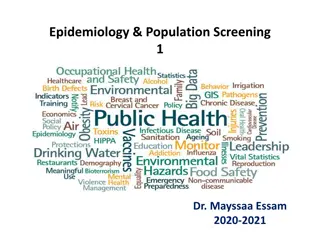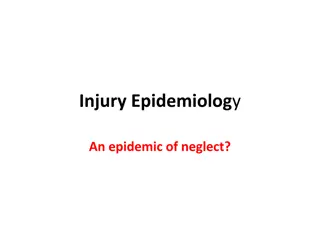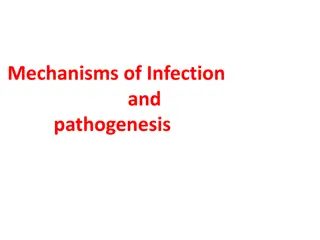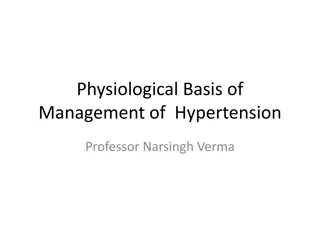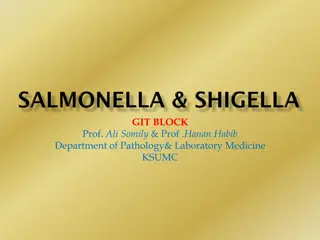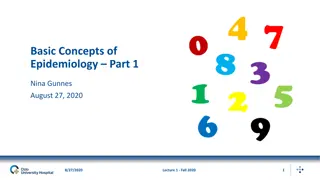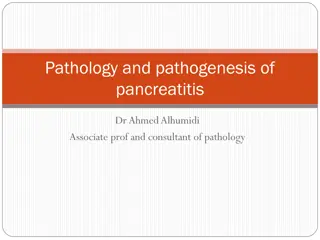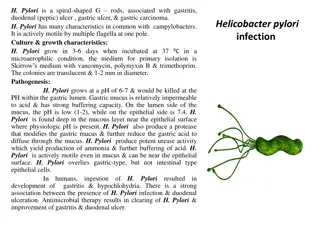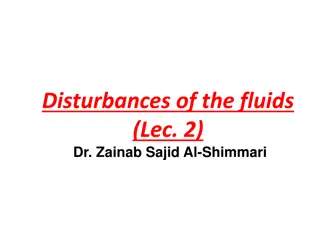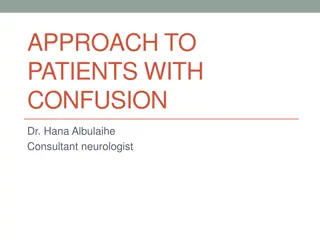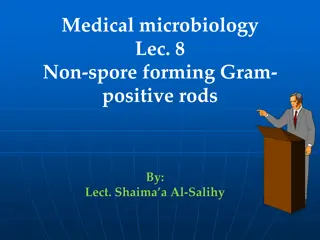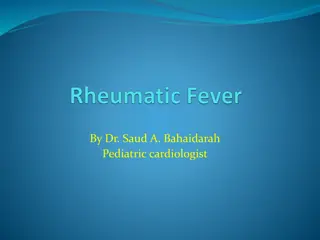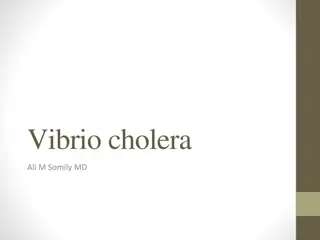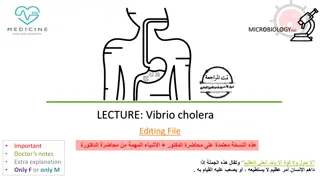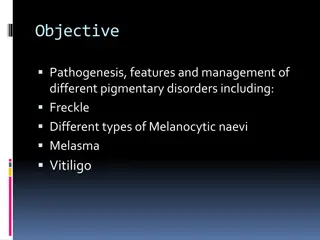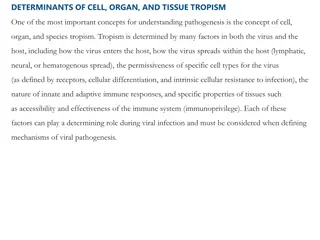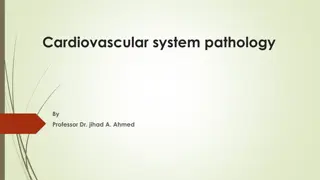Understanding Myocarditis: Epidemiology, Pathogenesis, and Management
Myocarditis is an inflammatory heart condition with various causes, including viral infections and autoimmune responses. This article discusses the epidemiology, risk factors, pathogenesis, diagnosis, and management of myocarditis, highlighting the importance of differentiating it from pericarditis for appropriate treatment.
Download Presentation

Please find below an Image/Link to download the presentation.
The content on the website is provided AS IS for your information and personal use only. It may not be sold, licensed, or shared on other websites without obtaining consent from the author. Download presentation by click this link. If you encounter any issues during the download, it is possible that the publisher has removed the file from their server.
E N D
Presentation Transcript
Prof . Hanan A. Habib & Dr.Khalifa BinKhamis hahabib@ksu.edu.sa &kbinkhamis@ksu.edu.sa Department of Pathology , Microbiology unit , College Of Medicine 2021
Objectives Describe the epidemiology, risk factor for myocarditis. Explain the pathogenesis of myopericarditis. Differentiate between the various types of myocarditis and pericarditis. Name various etiological agents causing myocarditis and pericarditis. Describe the clinical presentation and differential diagnosis of myocarditis and pericarditis. Discuss the microbiological and non microbiological methods for diagnosis of myocarditis and pericarditis. Explain the management ,complication and prognosis of patient with myocarditis and/or pericarditis.
Myocarditis Myocarditis : an inflammatory disease of the heart muscle. Mild & self-limited with few symptoms OR severe with progression to congestive heart failure & dilated cardiac muscle. localized or diffuse Myocarditis can be due to a variety of infectious and non infectious causes eg. toxins, drugs and hypersensitivity immune response. Viral infection is the most common cause
Myocarditis http://t2.gstatic.com/images?q=tbn:MweNbn2qR_mFOM:http://www.pathguy.com/lectures/giant_cell_myocarditis.jpg http://t2.gstatic.com/images?q=tbn:Lpz7gAqoAMnefM:http://2.bp.blogspot.com/_uiyskjNZYt8/TGUw6IjivGI/AAAAAAAAB98/XnKD1mGoIsc/s1600/Myocarditis.jpg http://t2.gstatic.com/images?q=tbn:cyuc8oIExzKr7M:http://embryology.med.unsw.edu.au/Defect/images/Coxsackie_B4_virus.jpg
Epidemiology ,Etiology and Risk Factors Epidemiology : no accurate estimate of incidence as many cases are mild & brief and diagnosis is not made. Etiology : Coxsackie virus B is the most common cause of myocarditis. Other virus : Coxsackie virus A, Echoviruses, Adenoviruses ,Influenza, EBV, Rubella, Varicella, Mumps, Rabies, Hepatitis viruses and HIV. Bacterial causes include Corynebacterium diphtheriae, Syphilis ,Lyme disease or as a complication of bacterial endocarditis .
Etiology-continue Parasitic causes includes Chagas diseases, Trichinella spiralis, Taxoplasma gondii and Echinococcus. Others organisms include: Rickettsiae, Fungi, Chlamydia, enteric pathogens, Legionella and Mycobacterium tuberculosis. Giant cell myocarditis due to Thymoma, SLE (systemic lupus erythromatosis ) or Thyrotoxicosis.
Infectious Noninfectious Systemic Diseases 1. SLE 2. Sarcoidosis 3. Vasculities(Wegener s disease) 4. Celiac disease Neoplastic infiltration Viruses 1. 2. Coxsackie B HIV Bacterial 1. Corynebacterium diphtheriae (diphtheria) Protozoan 1. Trypanosoma cruzi disease) Drugs & Toxins 1. Ethanol 2. Cocaine 3. Radiation 4. Chemotherapeutic agents - Doxorubicin (Chagas Spirochete 1. Borrelia burgdorferi ( Lyme disease)
Clinical presentation of myocarditis Highly variable :may occur days to weeks after onset of acute febrile illness or with heart failure without any known antecedent symptoms . Fever, headache, muscle aches, diarrhea, sore throat and rashes similar to most viral infections Chest pain, arrhythmias ,sweating , fatigue and may present with congestive heart failure.
Differential Diagnosis Acute Myocarditis Vasculitis Cardiomyopathy ( due to drugs or radiation)
Diagnosis of myocarditis WBCs, ESR, Troponin and CK-MB usually elevated ECG (nonspecific ST-T changes and conduction delays are common) Blood culture Viral serology and other specific tests for Lyme disease, diphtheria and Chagas disease may be indicated on a case by case basis. Chest X-rays : show cardiomegaly Radiology : MRI and Echocardiogram Heart muscle biopsy (for some cases)
Endomyocardial diagnosis Pathologic examination is not sensitive . It may reveal lymphocytic inflammatory response with necrosis. Giant cells may be seen.
Management of myocarditis Often supportive: restricted physical activity in heart failure. Specific antimicrobial therapy is indicated when an infecting agent is identified. Treatment of heart failure arrhythmia Other drugs indicated in special situations like anticoagulant, NSAID (non-steroidal anti-inflammatory drugs) , steroid or immunosuppressive immunomodulatory agents. Heart transplant
Management of myocarditis Most cases of viral myocarditisare self limited. One third of the patients are left with lifelong complications, ranging from mild conduction defects to severe heart failure. Patient should be followed regularly every 1-3 months. Sudden death may be the presentation of myocarditis in about 10% of cases.
Pericarditis Pericarditis is an inflammation of the pericardium usually of infectious etiology ( viruses, bacterial, fungal or parasitic) Etiology : (infectious and non-infectious). Infectious causes : Viral Pericarditis: Coxsackie virus A and B, Echovirus are the most common causes. Other viruses includes Herpes viruses, Hepatitis B , Mumps, Influenza, Adenovirus ,Varicella and HIV.
Bacterial Pericarditis usually a complication of pulmonary infections (e.g. pneumonia ,empyema): organisms :S. pneumoniae, M. tuberculosis, S. aureus, H. influenzae, K. pneumoniae , Legionella pneumophila, Mycoplasma pneumoniae & Chlamydia pneumoniae . HIV patients may develop pericardial effusions caused by: M.tuberculosis or M. avium complex. Disseminated fungal infection caused by : Histoplasma, Coccidioides. Parasitic infections eg. disseminated toxoplasmosis, contagious spread of Entamoeba histolytica - are rare causes.
Non-infectious pericarditis: Causes: Immune mediated : rheumatic fever & SLE Miscellaneous : due to myocardial infarction , malignancy and uremia.
Pathophysiology Contiguous spread lungs, pleura, mediastinal lymph nodes, myocardium, aorta, esophagus, liver. Hematogenousspread septicemia, toxins, neoplasm, metabolic Lymphangeticspread Traumatic or irradiation
Pathophysiology Inflammation provokes fibrinous exudate with or without serous effusion The normal transparent and glistening pericardium is turned into a dull, opaque, and sandy sac Can cause pericardial scarring with adhesions and fibrosis.
Types of Pericarditis Caseous Pericarditis commonly tuberculous in origin. Serous Pericarditis due to autoimmune diseases (rheumatoid arthritis, SLE), viral infections Transudative serous fluid Fibrinous Pericarditis due to acute MI, uremia, radiation Fibrinous exudative fluid
Types of Pericarditis Purulent/Suppurative pericarditis due to bacteria, fungi or parasites. Purulent exudative fluid Hemorrhagic pericarditis usually caused by infection (e.g. TB) or malignancy blood mixed with a fibrinous or suppurativeeffusion
Constrictive Pericarditis causes: Idiopathic Radiotherapy Cardiac surgery Connective tissue disorders Dialysis Bacterial infection ( viral, TB, fungal) 25
Clinical presentation of pericarditis Acute pericarditis: Sudden pleuritic chest pain which is positional retrosternal l(relieved by setting forward) Dyspnea Fever On examination : Pericardial rub, exaggerated pulses , paradoxus JVP (jugular venous pressure) and tachycardia. As the pericardial pressure increases, palpitations , presyncope or syncope may occur. Chronic pericarditis: Tuberculous pericarditis has insidious onset .
Tuberculous Pericarditis Incidence of pericarditis in patients with pulmonary TB ranges from 1 8 % Clinical findings: fever, pericardial friction rub, hepatomegaly Tuberculin skin test usually positive Fluid smear for acid fast bacilli (AFB ) often negative Pericardial biopsy more definitive 27
Acute Pericarditis Differential Diagnosis Acute myocardial infarction Pulmonary embolism Pneumonia Aortic dissection
Investigations & Diagnosis ECG will show ST elevation, PR depression and T-wave inversion may occur later. Blood culture Leukocytosis and an elevated ESR are typical Other routine testing : urea and creatinine. Tuberculin skin test is usually positive in tuberculous pericarditis cases. Chest x-ray may show enlarged cardiac shadow or calcified pericardium and CT scan show pericardial thickening >5mm. Pericardial fluid or pericardial biopsy specimens for fungi. Immunology /Serology : Antinuclear antibody tests and Histoplasmosis complement fixation indicated in endemic area.
http://t2.gstatic.com/images?q=tbn:ErpFm17iWhxS3M:http://www.uninet.edu/cin2003/conf/agarwal/fig3.jpghttp://t2.gstatic.com/images?q=tbn:ErpFm17iWhxS3M:http://www.uninet.edu/cin2003/conf/agarwal/fig3.jpg
Management of pericarditis Management is largely supportive for cases of idiopathic and viral pericarditis including bed rest , NSAIDS and Colchicine. Corticosteroid use is controversial and anticoagulants usually contraindicated. Specific antibiotics must include activity against S. aureus and respiratory bacteria. Antiviral: Acyclovir for Herpes simplex or Varicella . Ganciclovir for CMV .
Management of pericarditis Pericardiocentesis : a therapeutic procedure to remove fluid from the pericardium (to relief Tamponade) in severe cases with pericardial effusion. Patients who recovered should be observed for recurrence. Symptoms due to viral pericarditis usually subsided within one month.
Reference book Ryan, Kenneth J. Sherris Medical Microbiology. Latest edition. Mc Graw Hill education
Tutor contact hahabib@ksu.edu.sa hahabib@ksu.edu.sa For questions and queries contact tutor :


